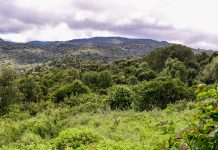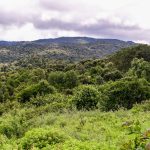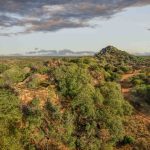A shocking new report by the Wildlife Conservation Society (WCS) and Fauna & Flora International has documented a catastrophic collapse of the world’s largest primate – the Grauer’s gorilla – due to a combination of illegal hunting, civil unrest, and habitat loss from mining.
The report points to a 77% drop in gorilla numbers, from an estimated 17,000 in 1995 to just 3,800 individuals today. Grauer’s gorillas – the world’s largest gorilla subspecies weighing up to 400 pounds – are closely related to the better known mountain gorilla. The subspecies is restricted to eastern Democratic Republic of Congo (DRC).
The decline in Grauer’s gorillas can be traced back to the Rwandan genocide in 1994, which forced hundreds of thousands of refugees to flee to the DRC. This in turn led to the DRC civil war in 1996, which continued until 2003 with devastating consequences, including an estimated 5 million people killed. But beyond the human tragedy, the war has also taken its toll on the DRC’s wildlife as a result of insecurity, heightened illegal bushmeat trade and increased deforestation.
The authors of the report sought to assess the impact of the civil war on Grauer’s gorilla numbers, which were estimated at 17,000 before the conflict. Field teams conducted widespread surveys, the most intensive ever for this ape, in regions beset by insecurity, searching for ground nests and other signs of this elusive ape. In addition, the authors employed a novel method that allowed them to rigorously assess data collected by local community members and rangers to estimate Gorilla abundance.
The authors say that halting and reversing the decline of Grauer’s gorilla will take considerable effort and will require more funding than is currently available. Artisanal mining must be controlled and the various armed groups that control mines disarmed. To accomplish this, it will be necessary to halt mining in protected areas, as it is known that miners subsist on bushmeat and hunt gorillas around their camps.
Three areas are now particularly crucial for the gorilla’s survival: Kahuzi-Biega National
Park, the adjacent Punia Gorilla Reserve where WCS is supporting gorilla conservation, and the remote unprotected Usala Forest which has no support currently. The Itombwe
Reserve and the Tayna regions also support highly-important outlying populations. It is critical to formally gazette the Itombwe and Punia Reserves, which have community support but are not yet legally established.
Park guards continue to be at risk – on March 31st, a guard was killed by armed rebels in an ambush in the forest of the highland sector of Kahuzi Biega National Park, the only site where the study found gorillas were increasing.
“We urge the government of DRC to actively secure and manage this part of the country for both human welfare as well as the survival of this gorilla,” said the study’s lead author Andrew Plumptre of WCS. “Significantly greater efforts must be made for the government to regain control of this region of DRC. In particular, the government needs to quickly establish Reserve des Gorilles de Punia and the Itombwe Reserve, and reinforce Kahuzi-Biega National Park efforts, which have community support, and to establish strong coordination between ICCN and the DRC military to tackle armed militias that control mining camps in Grauer’s gorilla heartland.”
Stuart Nixon of Fauna & Flora International, one of the co-authors involved in the study stated; “Grauer’s gorilla is found only in the eastern Congo – one of the richest areas on our planet for vertebrate diversity. As one of our closest living relatives, we have a duty to protect this gorilla from extinction. Unless greater investment and effort is made, we face the very real threat that this incredible primate will disappear from many parts of its range in the next five years. It’s vital that we act fast.”
Radar Nishuli, Chief Park Warden for the Kahuzi Biega National Park and another co – author, said: “What we have found in the field is extremely worrying. We are urging a strong and targeted response that addresses the following: Train, support and equip ecoguards to tackle poaching more effectively; build intelligence networks, and support the close daily monitoring of gorilla families to ensure their protection; engage customary chiefs who hold traditional power in the region to educate their communities to stop hunting these apes.” (Source; Fauna & Flora International)























